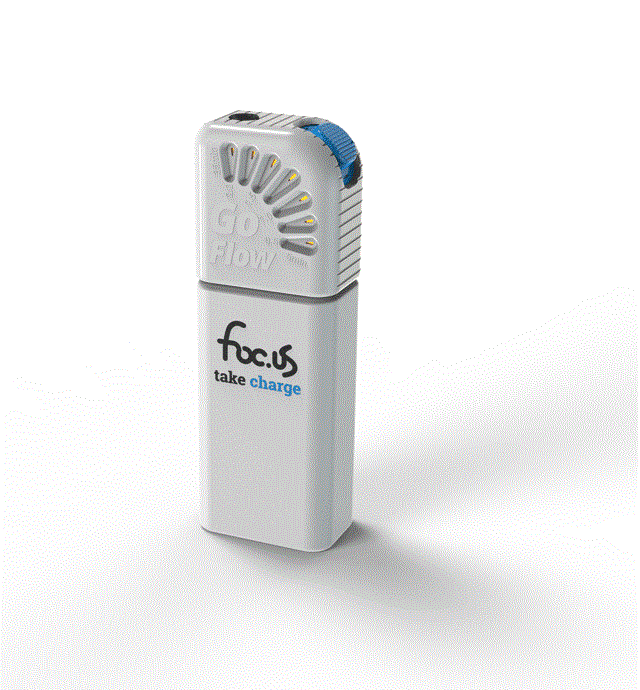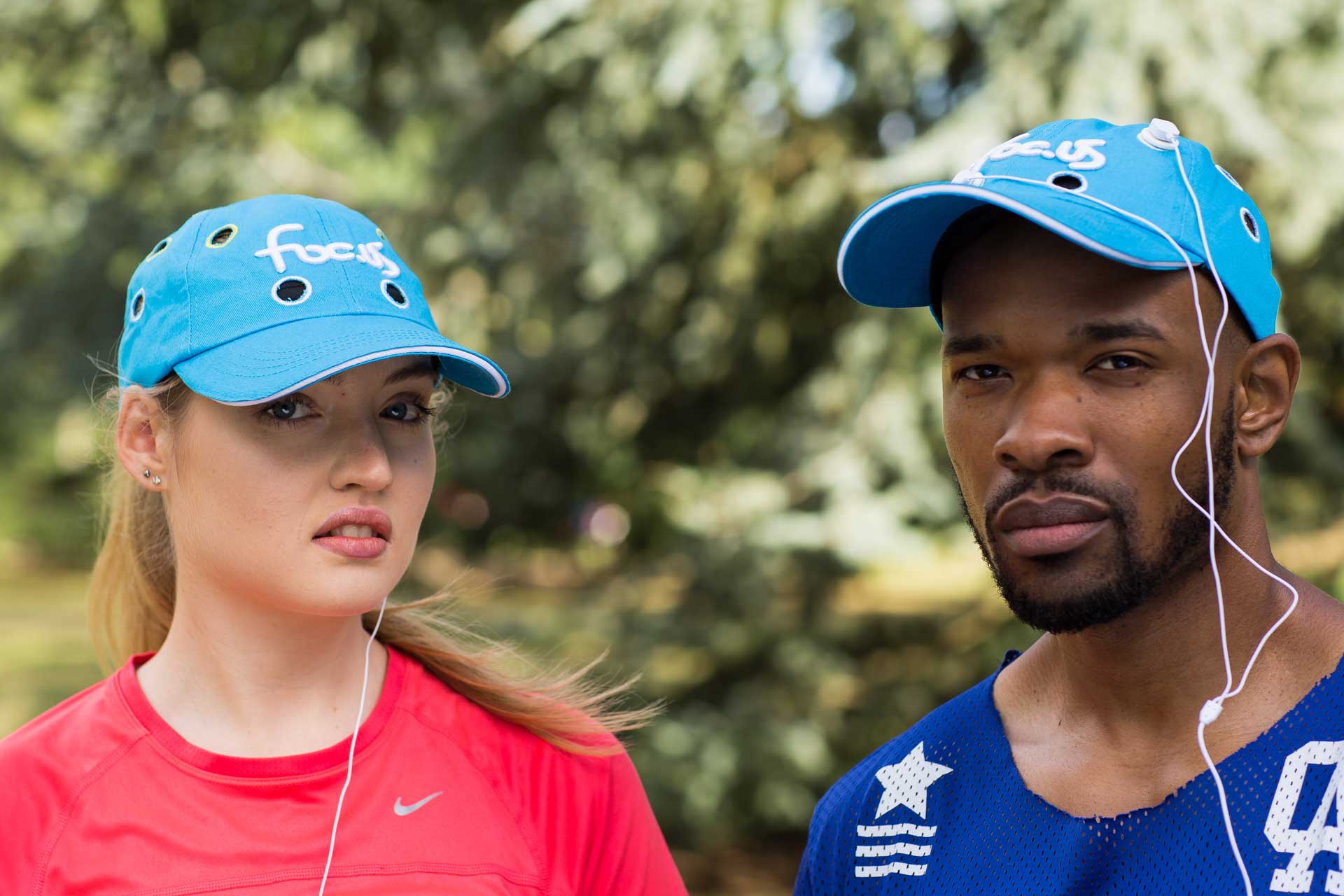Go Flow Pro
| Go Flow | |
|---|---|

|
|
| Category | Transcranial direct-current stimulation |
| Developer | Foc.us |
| Announced | March 2012 [1] |
| Released | Developers:
Consumers: June 2013 [2] |
| Price | 99 USD / 129 USD Go Flow Sports (November 2016) [3] |
| Max output | 2.2 mA2.2 T 0.0022 A [4] |
| Session duration | 2100 s35 minute [4] |
| Scalp location | T3, C3, C1, C2, C4, T4. F3, F4. Fp1, Fp2 [5] |
| Weight | 10 g [5] |
| Controls |
button [5] |
| Data available | |
| Risk factor | |
| Medical prescription | No |
| http://eu.foc.us/ | |
GoFlow is a small head mounted device which provides a certain form of brain stimulation, namely transcranial direct-current stimulation. The device was developed by London based company Foc.us, even though, the similar title was used also by one of the first tDCS devices, which produced by students at the University of Michigan and was never shipped.[1] The device consists of two electrodes, Go Flow tDCS stimulator, two cables, 9V battery, and band or cap which holds the electrodes on user's head. Go Flow Sports also includes armband.[5]
There are two types of devices sell under the name "Go Flow Pro" and "Go Flow Sports". The former device was intended to be low cost and reliable DIY (do-it-yourself) tDCS.[6] The developers do not suggest any use of the device. The latter type of the device is a device which should enhance physical performance.[5]
http://www.diytdcs.com/tag/goflow/
Contents
Main characteristics
Go Flow is standalone and fully enclosed head mounted tDCS device. The set includes the brain stimulator, two sponge electrodes, a band respectively a cap with armband, two cables and 9 V battery.[5] The device is intended as DIY tDCS device, thus components could be bought separately.[7] In addition, sticky electrodes with hydrogel could be used with the device.[8]
The Go Flow brain stimulator is small plastic box of size 26 mm x 28 mm x 16 mm. It contains one button which controls the setup of each session. There are also located orange and green LED lights, which indicates the output of the device and the duration of the session. The output can vary from 0.5 mA to 2 mA and the session duration from 5 minutes to 35 minutes.[5]
The device consists of two electrodes X and Y. "X" is a title for an anode and "Y" for a cathode. Each electrode has also its cable. The original package contains sponge electrodes which have to be wet by water or saline before the start of the session.[5] The users can used also hydrogel pads.[8] In that case, the skin under the electrodes have to be clean, in order to avoid injuries.[9]
Go Flow Sports includes also the sport cap and armband, which holds electrodes on the head or arm of users. The cap contains holes in the certain regions of scalp which ensure more precise placement of electrodes. The various placements of electrodes with regard to expected outcome of the session is described in Go Flow Sports booklet.[5]
The session begins with the watering of electrodes. Then the electrodes are fastened to the head by the cap or the bend. In the case that the user intends to put cathode on his or her arm and he or she owns Go Flow Sports, he or she can fasten it by armband. The cables are adjusted by magnets to the electrodes. Finally, cables are connected to the brain stimulator and the setting of the session is designed by the button. The booklet of Go Flow Sports suggests four possible settings of the session: training longer, training harder, learning new skills and getting into the zone.[5]
The title "GoFlow" was originally used for the device which was developed by two students at the University of Michigan Matt Sornson and Nick Woodhams as a prototype in 2012. They intended their device to be a first tDCS kit, which is publicly available. Due to FDA concerns and personal problems of the founders, the Kickstarter campaign was cancelled.[1] Later on, the founders supported the device which was developed by Foc.us.[2] In 2016, Foc.us have been developing a device which would be reliable and considerably cheap. They entitled it "Go Flow" as the allusion of the previously mentioned project.[6]
Purpose
The main purpose is to enhance skills of its users by affordable and reliable tDCS device. The specific ability which is enhanced depends on the placement of electrodes. Go Flow Sports focuses on the enhancement of motor skills.
Company & People
An available tDCS device was originally developed by students at the University of Michigan. Nevertheless, the current device is shipped by Foc.us company, which is based in London, UK. This company was founded by two engineers. They claim, however, that they cooperate with neuroscientist.[10]
- Michael Oxley - the co-founder and CEO of Foc.us
- Martin Skinner - the co-founder of Foc.us[10]
- Matt Sornson - the co-founder of GoFlow
- Nick Woodhams - the co-founder of GoFlow[1]
Important Dates
- spring 2012 - the new device was announced and the Kickstarter campaign began
- May 2012 - the Kickstarter campaign was delayed and later cancelled because of FDA involvement
- early 2013 - the developers give up the development of an available tDCS device and sold the project to the Foc.us company
- summer 2013 - the first device tDCS which was produced by Foc.us was released[1]
- November 2015 - Foc.us decided to built an accurate, reliable and affordable tDCS device
- January 2016 - Focus Go Flow device was unveiled[6]
- September 2016 - Foc.us introduced Go Flow Sports[11]
- October 2016 - Go Flow Sports began shipping[12]
Enhancement/Therapy/Treatment
There is no claim, .
Go Flow Sport is clearly intended as a device which enhance physical skills. The booklet describe several placement of electrodes which could enhance certain abilities.[5] The enhancement is described in a more detail in Foc.us blog posts[13][14][15]
Go Flow is not a medical device and the developers are quite cautious not to put any misleading claim on Go Flow's webpage. They argue:
tDCS can help increase your focus, working memory and endurance. These are the only benefits we recommend using tDCS for. If you have a medical condition you are hoping to treat you should not consider foc.us. If you have any medical questions we cannot help you, sorry.[16]
Consequently, the device is not regulated by FDA. There is, however, Foc.us' motto "take charge" which could be considered as a kind of medical claim.[1]
Ethical & Health Issues
There were reported injuries caused by sticky electrodes which were used in a certain types of Go Flow devices:
Recently, we've seen an increased interest in using tDCS devices with sticky electrodes (primarily because this is one of the default configurations of the foc.us GoFlow device which launched recently). Coincident with this, we've seen an increase in reports of injuries from sticky electrodes.[9]
Public & Media Impact and Presentation
Public Policy
Related Technologies, Projects or Scientific Research
References
- ↑ 1.0 1.1 1.2 1.3 1.4 1.5 WEXLER, Anna. A pragmatic analysis of the regulation of consumer transcranial direct current stimulation (TDCS) devices in the United States. Journal of Law and the Biosciences [online]. 2015, Oct 12. Available online at: http://jlb.oxfordjournals.org/content/2/3/669.full.pdf+html (Retrieved 1st November, 2016).
- ↑ 2.0 2.1 JOHN. News from GoFlow! Good and Bad. DIY tDCS [online] 2013, Jun 7. Available online at: http://www.diytdcs.com/2013/06/news-from-goflow-good-and-bad/ (Retrieved 1st November, 2016).
- ↑ Foc.us. Hardware. Foc.us [online]. Available online at: http://eu.foc.us/all-products?SID=8ra4r8d2os79ll9iclduh9dmj7?SID=8ra4r8d2os79ll9iclduh9dmj7 (Retrieved 11th November, 2016).
- ↑ 4.0 4.1 Foc.us. Go Flow Pro - Stimulator, Cable, Sponge holders, Sponges & Headband. Foc.us [online]. Available online at: http://eu.foc.us/go-flow-pro-brain-stimulator (Retrieved 11th November, 2016).
- ↑ 5.00 5.01 5.02 5.03 5.04 5.05 5.06 5.07 5.08 5.09 5.10 Foc.us. Focus Go Flow Manual & Instruction Booklet. Foc.us [online]. Available online at: http://help.foc.us//article/38-focus-go-flow-manual-instruction-booklet
- ↑ 6.0 6.1 6.2 OXLEY, Michael. The Story of Focus Go Flow. Foc.us Blog [online]. 2016, Jan 5. Available online at: https://www.foc.us/blog/the-story-of-focus-go-flow.html (Retrieved 14th November, 2016).
- ↑ Foc.us. Hardware. Foc.us [online]. Available online at: http://eu.foc.us/all-products?SID=s0b48plhgmpu759m4s164fbgr1 (Retrieved 15th November, 2016).
- ↑ 8.0 8.1 Foc.us. Go Flow Try tDCS - Stimulator, Cable & Pads. Foc.us [online]. Available online at: http://eu.foc.us/go-flow-try-me (Retrieved 15th November, 2016).
- ↑ 9.0 9.1 OHSNAPITSNATHAN. PSA: Sticky electrodes and skin burns. Reddit [online]. 2016, Jul 2. Available online at: https://www.reddit.com/r/tDCS/comments/4qx8ic/psa_sticky_electrodes_and_skin_burns/ (Retrieved 14th November, 2016).
- ↑ 10.0 10.1 GEUSS, Megan. The gaming headset that (literally) shocks your brain to attention. Ars Technica [online]. 2013, May 19. Available online at: http://arstechnica.com/gaming/2013/05/the-gaming-headset-that-literally-shocks-your-brain-to-attention/ (Retrieved 15th November, 2016).
- ↑ OXLEY, Michael. Foc.us Launches tDCS Performance Enhancement for Pro and Amateur Athletes. Foc.us Blog [online]. 2016, Sep 21. Available online at: https://www.foc.us/blog/focus-launches-tdcs-performance-enhancement-for-pro-and-amateur-athletes.html (Retrieved 15th November, 2016).
- ↑ OXLEY, Michael. 1st October Update. Foc.us Blog [online]. 2016, Oct 1. Available online at: https://www.foc.us/blog/1st-october-update.html (Retrieved 16th November, 2016).
- ↑ RAJESH. Last longer and train harder: Foc.us on endurance. Foc.us Blog [online]. 2016, Oct 10. Available online at: https://www.foc.us/blog/last-longer-and-train-harder-focus-on-endurance.html (Retrieved 16th November, 2016).
- ↑ OXLEY, Michael. tDCS Placements 10/20 Guide. Foc.us Blog [online]. 2016, Sep 1. Available online at: https://www.foc.us/blog/tdcs-placements-10-20-guide.html (Retrieved 16th November, 2016).
- ↑ RAJESH. Achieve Sporting Prowess with Foc.us Brain Stimulation. Foc.us Blog [online]. 2016, Jul 25. Available online at: https://www.foc.us/blog/achieve-sporting-prowess-with-focus-brain-stimulation.html (Retrieved 16th November, 2016).
- ↑ FOC.US. DIY tDCS. Foc.us [online]. Available online at: http://www.foc.us/diy-tdcs (Retrieved 16th November, 2016).


